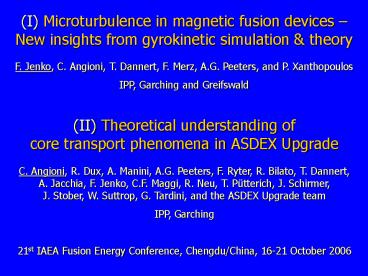ETG high-amplitude streamers PowerPoint PPT Presentation
Title: ETG high-amplitude streamers
1
(I) Microturbulence in magnetic fusion devices
New insights from gyrokinetic simulation
theory F. Jenko, C. Angioni, T. Dannert, F.
Merz, A.G. Peeters, and P. Xanthopoulos IPP,
Garching and Greifswald
(II) Theoretical understanding of core transport
phenomena in ASDEX Upgrade C. Angioni, R. Dux,
A. Manini, A.G. Peeters, F. Ryter, R. Bilato, T.
Dannert, A. Jacchia, F. Jenko, C.F. Maggi, R.
Neu, T. Pütterich, J. Schirmer, J. Stober, W.
Suttrop, G. Tardini, and the ASDEX Upgrade team
IPP, Garching 21st IAEA Fusion Energy
Conference, Chengdu/China, 16-21 October 2006
2
A rough outline of this talk
Complex phenomena
PART II
PART I
Quasilinear models
Nonlinear gyrokinetic simulations
All nonlinear gyrokinetic simulations shown in
this talk have been performed with the continuum
code GENE.
3
Adiabatic ITG turbulence in a simple tokamak
- Reference case for core turbulence simulations
- Cyclone base case also serves as standard
paradigm of turbulence - idealized physical parameters adiabatic
electrons s-a model equilibrium
- Key findings
- saturation via zonal flows
- ion heat flux is offset-linear
- nonlinear upshift of threshold
GENE data
What about all the other transport channels? How
generic is the adiabatic ITG s-a scenario?
4
Microturbulence in stellarators
5
An example Wendelstein 7-X
W7-X is minimized with respect to neoclassical
losses Role of turbulent transport
in (optimized) stellarators? Effect of magnetic
geometry on turbulence (tokamak edge etc.)?
A R/a gt 10
6
Adiabatic ITG turbulence in the stellarator W7-X
increasing R/LTi
linear threshold R/LTi 9 (a/LTi 1)
Nonlinear upshift of critical temperature
gradient by some 20. Very low transport levels
due to strong zonal flow activity (?E?).
7
TEM turbulence in tokamaks
8
Basic properties of TEM turbulence
- Systematic gyrokinetic study of TEM turbulence
- Relatively weak zonal flow activity
- 2. Formation of radial structures
- 3. Structures appear to be remnants of linear
modes
Dannert Jenko 05
9
Nonlinear saturation in TEM turbulence
For the transport-dominating modes, the ExB
nonlinearity is well represented by a diffusivity
transport dominating regime
transport dominating regime
10
Nonlinear saturation in TEM turbulence (contd)
Dressed test mode approach in the spirit of
renormalized perturbation theory explains
nonlinear saturation and serves as basis for a
transport model.
Dressed test mode approach
Parallel weighting
weighting function
11
A novel quasilinear transport model
Qi and G from QL ratios
weighted w.r.t. parallel mode structure
QL model
NL GK simulation
This model is able to capture key features of
TEM turbulence and can be used to predict
TEM-induced transport.
12
An empirical critical gradient model
- Many dedicated experiments with dominant
electron heating - Transport is dominated by TEM turbulence (low Ti
? ETG modes stable) - Interpretation via an empirical critical
gradient (CG) model - Confirmed by nonlinear gyrokinetic simulations
with GENE
F. Imbeaux et al., PPCF 2001 X. Garbet et al.,
PPCF 2004
R/Ln 0
13
R/LTe dependence for large density gradients
R/Ln gt 2.5 Conventional (quasi-)linear
models no critical gradient (density gradient
drive) Nonlinear simulations and new
quasilinear model effective critical
gradient electron heat flux has offset-linear
scaling
- similar as in adiabatic ITG case
- implies Te profile stiffness
- coupling of particle and electron heat flux
14
q dependence of TEM-induced transport
Conventional QL theories predict a relatively
weak dependence on q, but
15
States of zero particle flux in ITG-TEM turbulence
Observation of a particle pinch (G lt 0) for low
values of R/Ln (ITG regime).
? ß 0
Jenko, Dannert Angioni 05
16
Experimental identification of TEM features
17
Existence of a threshold in R/LTe
- AUG L-mode plasmas
- 0.8 MW ECRH, little OH)
- gradual reduction of central ECRH, balanced by
increase - of off-axis heating
F. Ryter et al., PRL 2005
ETG stable
Threshold behavior is observed directly power
balance and transient transport consistent with
both linear gyrokinetics and CG model.
18
Collisional stabilization of TEMs
Density ramp in AUG L-mode plasmas and
quasilinear analysis
With increasing collisionality, the R/LTe
dependence of the electron heat flux decreases.
Eventually, the dominant mode changes from TEM to
ITG.
19
Impurity transport in the core
20
Experimental observations in AUG
General finding No central impurity
accumulation when central heat transport is
anomalous! Example W accumulation is
suppressed by 0.8 MW of central ECRH during
a high density phase with 5 MW of NBI
R. Neu et al., JNM 2003
21
Quasilinear gyrokinetic study of an impurity trace
15524 (ECRH phase mid radius)
nominal parameters R/LTzR/LTi (ITG) R/LTe ?
collisionality ? (TEM) W ionization stage
(Z46, A184 ITG)
R / Ln -R V / D
A 2 Z
In confinement region, impurity transport is
likely to be turbulent. High-Z limit is well
behaved in contrast to neoclassical theory.
22
Momentum and ion heat transport
23
Effects of electron heating on ion heat transport
- In very low density H-mode plasmas, one finds a
strong - confinement degradation in response to central
ECRH - Related R/LTi drop due to increase of Te/Ti
(implies reduction - of ITG threshold) and reduction of vtor
(decrease of ?E)
A. Manini et al., NF submitted
24
Coupling of momentum and ion heat transport
- Strong correlation between
- ?Ti and ?vtor
- Consistent with constant ratio
- of ?F / ?i
- Power balance analysis (ASTRA,
- FAFNER, TRANSP, TORIC) yields
- a ratio of 1 at mid radius
- Promising agreement with both
- quasilinear and nonlinear
- GK studies of ITG modes
A. Peeters et al., PoP 05 PPCF submitted
25
Insights and conclusions
- Specific insights
- The adiabatic ITG paradigm is not universal
(see, e.g., TEM) - QL models can be quite successful when used with
care - Experimental TEM studies can be related to NL
gyrokinetics - Different transport channels tend to be strongly
coupled - General conclusions
- No real predictive capability without deeper
understanding - There is room for more synergy between theory,
modelling, and experiment - See posters EX / 8-5Ra EX / 8-5Rb

